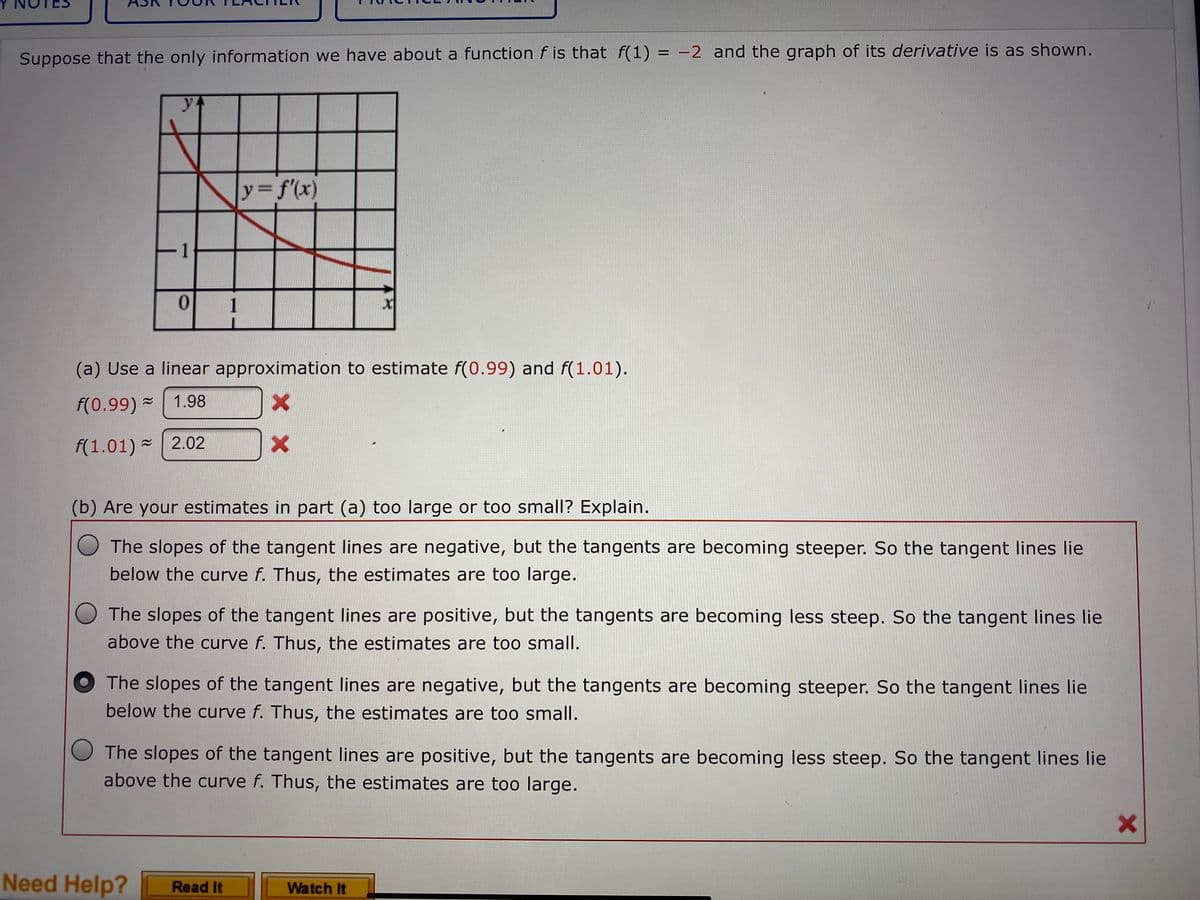(a) Use a linear approximation to estimate f(0.99) and f(1.01). f(0.99) = 1.98 f(1.01) 2.02 (b) Are your estimates in part (a) too large or too small? Explain. The slopes of the tangent lines are negative, but the tangents are becoming steeper. So the tangent lines lie below the curve f. Thus, the estimates are too large. The slopes of the tangent lines are positive, but the tangents are becoming less steep. So the tangent lines lie above the curve f. Thus, the estimates are too small. The slopes of the tangent lines are negative, but the tangents are becoming steeper. So the tangent lines lie below the curve f. Thus, the estimates are too small. The slopes of the tangent lines are positive, but the tangents are becoming less steep. So the tangent lines lie above the curve f. Thus, the estimates are too large.
(a) Use a linear approximation to estimate f(0.99) and f(1.01). f(0.99) = 1.98 f(1.01) 2.02 (b) Are your estimates in part (a) too large or too small? Explain. The slopes of the tangent lines are negative, but the tangents are becoming steeper. So the tangent lines lie below the curve f. Thus, the estimates are too large. The slopes of the tangent lines are positive, but the tangents are becoming less steep. So the tangent lines lie above the curve f. Thus, the estimates are too small. The slopes of the tangent lines are negative, but the tangents are becoming steeper. So the tangent lines lie below the curve f. Thus, the estimates are too small. The slopes of the tangent lines are positive, but the tangents are becoming less steep. So the tangent lines lie above the curve f. Thus, the estimates are too large.
Functions and Change: A Modeling Approach to College Algebra (MindTap Course List)
6th Edition
ISBN:9781337111348
Author:Bruce Crauder, Benny Evans, Alan Noell
Publisher:Bruce Crauder, Benny Evans, Alan Noell
Chapter2: Graphical And Tabular Analysis
Section2.1: Tables And Trends
Problem 1TU: If a coffee filter is dropped, its velocity after t seconds is given by v(t)=4(10.0003t) feet per...
Related questions
Topic Video
Question
I guess I really had no idea how to do this since they are all wrong. Need help.

Transcribed Image Text:Suppose that the only information we have about a function f is that f(1) = -2 and the graph of its derivative is as shown.
y3 f'(x)
0.
(a) Use a linear approximation to estimate f(0.99) and f(1.01).
F(0.99) 1.98
f(1.01) 2.02
(b) Are your estimates in part (a) too large or too small? Explain.
O The slopes of the tangent lines are negative, but the tangents are becoming steeper. So the tangent lines lie
below the curve f. Thus, the estimates are too large.
The slopes of the tangent lines are positive, but the tangents are becoming less steep. So the tangent lines lie
above the curve f. Thus, the estimates are too small.
The slopes of the tangent lines are negative, but the tangents are becoming steeper. So the tangent lines lie
below the curve f. Thus, the estimates are too small.
The slopes of the tangent lines are positive, but the tangents are becoming less steep. So the tangent lines lie
above the curve f. Thus, the estimates are too large.
Need Help?
Read It
Watch It
Expert Solution
This question has been solved!
Explore an expertly crafted, step-by-step solution for a thorough understanding of key concepts.
This is a popular solution!
Trending now
This is a popular solution!
Step by step
Solved in 3 steps with 3 images

Knowledge Booster
Learn more about
Need a deep-dive on the concept behind this application? Look no further. Learn more about this topic, advanced-math and related others by exploring similar questions and additional content below.Recommended textbooks for you

Functions and Change: A Modeling Approach to Coll…
Algebra
ISBN:
9781337111348
Author:
Bruce Crauder, Benny Evans, Alan Noell
Publisher:
Cengage Learning

Trigonometry (MindTap Course List)
Trigonometry
ISBN:
9781337278461
Author:
Ron Larson
Publisher:
Cengage Learning

Functions and Change: A Modeling Approach to Coll…
Algebra
ISBN:
9781337111348
Author:
Bruce Crauder, Benny Evans, Alan Noell
Publisher:
Cengage Learning

Trigonometry (MindTap Course List)
Trigonometry
ISBN:
9781337278461
Author:
Ron Larson
Publisher:
Cengage Learning